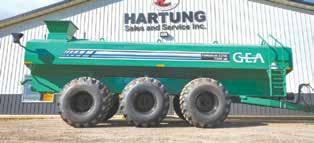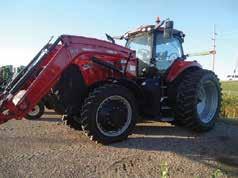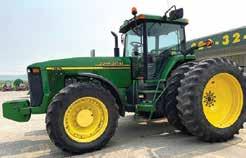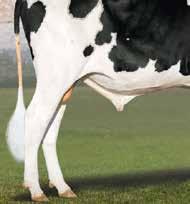
























































































































































































By Dan Wacker dan.w@dairystar.com
PROTIVIN, Iowa — Overlapping Chickasaw and Howard counties sits a private school in a small community that faced issues getting milk to students.
The school’s cook, Bonnie Malven, said Trinity Catholic School, with just 53 students, in Protivin, with just 300 residents, seemed unworthy of a milk delivery route. Malven has been the staff cook for 12 years.
“After COVID, we started having issues getting cartons,” Malven said. “We’re such a small school, no one wanted to deliver here. So we had to nd ways around it.”
Along with her duties at the school, Malven and her husband milked 40 Holstein cows near Protivin for 30 years until July 2024. Going without milk at school was unthinkable she said.
“Dairy is so important for kids, especially at this age,” Malven said. “The calcium for their bones, the vitamins for their growing bodies, it’s all very important to their development.”
Trinity Catholic School had been working with a local convenience store nearby to bring in cartons. Malven placed the school’s order in conjunction with the store’s order and then brought the product to school.
“Delivery to the convenience store worked for a while, but after COVID, we were consistently getting shorted,” Malven said. “We’d have weeks where we wouldn’t get our white milk order, or weeks we wouldn’t get chocolate, or weeks we wouldn’t get anything.”

To supplement the weeks that Malven was not receiving her order, she purchased gallons of milk to ensure that the kids were getting those nutrients. She then noticed a social media post from a cook from a neighboring school in Waukon who had a similar issue and moved to milk in bulk.
“At rst, I didn’t even know where to start,” Malven said. “I called my colleague at St. Patrick (Catholic) School in Waukon and she talked to me about
WW Homestead Dairy.”
WW Homestead Dairy was created in 2011. Two northeast Iowa families originated the local food market with products made from milk produced on the farms owned by Tom and Paul Weighner and Tom Walleser. WW Homestead Dairy was the main milk supplier for St. Patrick Catholic School, so Malven made a call.























Drain Tile Design/ Installation • Ditch Cleaning & Grading • Fenceline Clearing Changing weather and higher inputs got
-









“I told them right away that we’re a small school, but that wasn’t a problem to them at all,” Malven said. “I asked if they could deliver to the school, and as it turned out, we were right along their delivery route already. I was so excited I was nally going to get bulk milk.”
Fortune was with them because WW Homestead Dairy had a milk dispenser returned that was immediately available for Trinity Catholic School.
WW Homestead Dairy brought the machine to the school and set it up. They showed Malven how to place the milk, clean the machine and got her up to speed in running the machine.
“When we rst went with the dispenser in the spring of 2023, we had some doubters with the switch from cartons,” Malven said. “We shared a principal with St. Patrick’s in Waukon
and she was all for the switch, and after using it the rst few weeks, everyone came around.”
Malven said she is thankful for WW Homestead Dairy assisted her in getting milk back into her lunchroom on a consistent basis.
“It means so much to me that they’ve helped us out like they have,” Malven said.
With the dispenser, Malven has seen more milk consumption and less waste.
“There’s so much less trash now,” Malven said. “We used to have a bag of garbage every day, but now we can go a couple of days without it lling up. It wasn’t a driving force behind bringing in the dispenser, but it’s certainly been an added benet.”

Along with cutting down on paper waste, milk waste is also down.
“We’d get shipments of cartons and run into spoiled milk,” Malven said. “Or we’d have one child say they thought their milk tasted funny, and of course that set off a chain reaction in the cafeteria. Now the product is more consistent, better tasting and colder.”
Before the lunch bell rings each day, Malven empties the dispenser into pitchers to use rst when the kids arrive. She replaces the empty bulk milk bags with fresh bags in preparation for the lunchtime rush.
“With a school our size, it’s important that we have everything ready to go when the students get here,” Malven said. “We don’t have time to replace a bag in the middle of lunch, and I always want to make sure that our kids have the chance to have milk with their lunch. It’s so important for them, and with my background in dairy, it means a lot to me to see how happy they are when they are enjoying their lunch with a nice glass of milk on the side.”

































The U.S. Department of Agriculture published its Federal Order Final Decision. All 11 orders approved the nal changes. USDA said: “This nal rule amends the 11 FMMOs with implementation on June 1, 2025, except for the amendments to skim milk composition factors, which have a later implementation date.”
Increasing milk composition factors to 3.3% protein, 6% other solids, and 9.3% nonfat solids will be implemented Dec. 1, 2025. Barrel cheddar will be eliminated from milk pricing formulas and the Dairy Products Mandatory Reporting Program. The change will be instituted in June 2025. After this time, only block cheddar will be used to determine the monthly average cheese price.
Make allowances will increase and butterfat recovery in the Class III formula will be upped to 91% in June. The Class I mover returns to the higher of Class III or Class IV skim milk price and a rolling monthly Class I extended shelf life adjustment is included. Both will be implemented in June. Class I differentials will be altered in some regions, according to the USDA.
USDA lowered its milk production forecast from last month in its latest World Agricultural Supply and Demand Estimates, citing lower milk cow numbers and lower expected milk per cow based on the recent milk production report. The 2025 forecast was also lowered due to slower growth in output per cow.
2024 production and marketings were projected at 225.8 and 224.8 billion pounds respectively, down 500 million pounds on both from last month’s estimate. If realized, both would be down 600 million pounds or 0.3% from 2023.
2025 production and marketings were projected at 227.2 and 226.2 billion pounds, respectively, down 800 million on both. If realized, both would be up 1.4 billion pounds or 0.6% from 2024.
Class and product price estimates for 2024 were adjusted to reect reported prices. Prices for 2025 cheese, butter, nonfat dry milk and whey were expected to be higher due to less milk production and supportive demand. The Class III milk price was raised, with higher cheese and whey prices. Class IV milk prices were also raised, due to higher butter and NDM price forecasts.
The 2024 Class III average was lowered to $19.89 per hundredweight, down a penny from last month’s estimate, and compares to $17.02 in 2023 and $21.96 in 2022. The 2025 average was projected at $19.70, up 90 cents from a month ago.
The Class IV price will average $20.75 in 2024, unchanged from last month’s estimate, and compares to $19.12 in 2023 and $24.47 in 2022. The 2025 average was projected to hit $20.80, up 40 cents from last month’s projection.

This month’s U.S. corn outlook calls for lower production, feed and residual use, exports, and ending stocks. Corn production was estimated at 14.9 billion bushels, down 276 million as a 3.8-bushel per acre cut in yield to 179.3 bushels is partially offset by a 0.2-million acre increase in harvested area. Total corn use was down 75 million bushels to 15.1 billion. Feed and residual use was reduced 50 million bushels to 5.8 billion. Exports were cut 25 million bushels to 2.5 billion reecting lower supplies. Corn stocks were lowered 198 million bushels and the season-average corn price was raised 15 cents to $4.25 per bushel.
Soybean production was estimated at 4.4 billion bushels, down 95 million, led by decreases for Indiana, Kansas, South Dakota, Illinois, Iowa and Ohio. Harvested area was estimated at 86.1 million acres, down 0.2 million. Yield was estimated at 50.7 bushels per acre, down 1.0 bushel. Soybean ending stocks were projected at 380 million bushels, down 90 million. The U.S. season-average soybean price was projected at $10.20 per bushel, unchanged from last month, and soybean meal was increased $10 to $310 per short ton.
Dairy cow culling for the week ending Jan. 4 totaled 44,100 head, up 4,200 from the previous week, but 4,400 or 9.1% below a year ago.
Volatility hit the Chicago Mercantile Exchange cheese market the third week of 2025. The Cheddar blocks jumped 9 cents Monday, leaping to $1.91 per pound, then dropped 7.75 cents Wednesday, regained 6.75 cents Thursday, climbing back to $1.89, and stayed there Friday, up 7 cents on the week and 44.50 cents above a year ago.
The barrels marched to $1.89 Thursday, highest since Oct. 30, and that’s where they also nished Friday, 4 cents higher on the week and 42.25 cents above a year ago. CME sales totaled 13 loads of block on the week and seven of barrel.
Football playoffs are underway with the Super Bowl less than a month away, the prime cheese consumption time of the year, but cheese demand may lessen after that. HighGround Dairy’s “Monday Morning Huddle” said, “New cheese capacity in Kansas has been in operation for over two months, but the quality spec is likely not yet ready to pass a grade at the CME, though HighGround believes it is close. Leprino Foods’ new Lubbock, Texas, plant should be running soon but will also have a ramp-up period.”
Meanwhile, StoneX said, “It will be some time before the U.S. cheesemakers can build inventories at a more normal pace. Last week’s weakness clearly did not make buyers step away but in fact encouraged them to buy the dip. The market is telling us demand for cheese, be it pipeline relling or just building up some inventory, is still alive and well.”
“We’ve said that the $1.85-$1.95 cheese price average seems to be a good market clearing level for
cheese.” European Union Cheddar has been trending higher which could lend some support as they continue to trade at a strong premium to U.S. block prices,” said StoneX.
Midwest cheese production continues to pick up following the holiday downtime by quite a margin, according to Dairy Market News. Cheese demand throughout the region is steady to seasonally lighter. A number of cheddar and Italian-style cheesemakers say demand is meeting or beating seasonal expectations. Milk availability quickly tightened following the holiday lulls. Spot milk prices were above the Class III baseline at mid-week.
Western cheese production is steady to stronger. Steady or strengthening milk production in the region is providing more milk to cheese vats and demand for milk from cheesemakers is reportedly healthy. Demand from domestic and international buyers is mixed, said DMN.
Cash butter climbed to $2.6125 per pound Monday, highest since Nov. 15, 2024, but it closed Friday at $2.53, down 7 cents on the week and 1.5 cents below a year ago. There were 31 sales logged for the week.
The U.S. fat test is substantial and made a new record in November, according to HGD. “Concerns about milk production in the nation’s top-butter state may provide near-term support, though cream multiples remain historically low with multiple regions reporting ample availability.”
The Jan. 13 “Daily Dairy Report” said “The United States exported nearly 6.8 million pounds of butter in November, a substantial increase relative to November 2023, as U.S. product remained competitively priced. Despite this, the U.S. was a net importer of butter in November, bringing a record 16.4 million pounds ashore. This suggests that Americans purchased 241.4 million pounds of butter in November, the most for any month ever and 22% more than November 2023.”
Butter plants are working on building stocks for later in the year, namely spring demand, and some are ahead of schedule, said DMN. Cream availability is aiding the effort. Spot cream values mid-week had rallied. Multiples below the 1.00 mark during the holiday weeks and last week had yet to be seen. That said, cream remains widely available and some contacts on both sides of the equation do not expect tightness in cream until the spring holiday season.
Plenty of cream remains available in the West. Retail butter output is steady to stronger. Bulk output is mixed. Sellers note that demand varies from somewhat quiet to somewhat strong, according to DMN.
Grade A nonfat dry milk closed Friday at $1.3725 per pound, up 0.75 cents on the week, and 19.75 cents above a year ago, with six sales reported.












Dry whey nished the week a quarter-cent lower, at 73.75 cents per pound, 31 cents above a year ago. There were four CME sales put on the board this week.
Checking demand, the latest Livestock, Dairy, and Poultry Outlook reports November’s restaurant performance index, which tracks the health of the U.S. restaurant industry, increased 0.8% compared to the previous month, suggesting that more people are dining out. The index indicates that restaurants have been experiencing growth since October 2024, marking the rst expansion of the year. If this trend continues, it could benet the dairy industry as well, said the Outlook. Dairy consumption tends to be higher when consumers dine out.
Super Bowl cheese demand will soon be behind us, while plenty of new cheese-making capacity has or is coming online. China has not reliably returned to the dairy market and U.S. global price competitiveness is in question, and President Trump’s threats of tariffs overhang the markets. We also have bird u’s impact.
Rabobank’s Lucas Fuess said in the Jan. 20 “Dairy Radio Now” broadcast that domestic dairy demand continues to be OK despite the negative economic drivers, if you consider how much milk we consume in the U.S. The overall upside potential on milk prices will no doubt be limited, he admitted, however offsetting that, feed costs this year will likely be the lowest in 4-5 years, so we expect OK margins for dairy farmers. “If we can maintain milk prices around that $20-$21 mark, there are still opportunities for prot, regardless of the seemingly negative headwinds that we’re facing,” he said.
The biggest wildcard may be President Trump’s impact, be it the tariffs or the deportations, which could limit the farm labor force. Bird u is another concern, considering the huge impact it had on California in November, according to Fuess. It will be lessened over the winter, he said, “But we will watch that sharply into the spring as birds start migrating again. The USDA is testing several vaccines, so hopefully, we get some good news on that front.”
Fluid milk sales are seeing some ups and downs after topping year-ago levels in six out of 2024’s rst nine months. USDA’s latest data shows November packaged sales at 3.6 billion pounds, down 1.5% from November 2023.
Conventional product sales totaled 3.4 billion pounds, down 2.2% from a year ago, while organic products, at 249 million pounds, were up 7.7%. Organic sales represented 6.8% of total sales for the month.
Whole milk sales totaled 1.3 billion pounds, off 0.4%, following an impressive 3.6% jump in October, and were up 1.9% year to date, representing 35.2% of total sales for the month. Skim milk sales, at 150 million pounds, were down 6.5% from a year ago, and down 10.4% year to date.
Packaged uid sales in the 11 month period totaled 39.2 billion pounds, up 0.7% from 2023. Conventional product sales totaled 36.5 billion pounds, up 0.2% from a year ago. Organic products, at 2.8 billion pounds, were up 6.9%, and represented 7.1% of total milk sales in the 11 months. The gures represent consumption in Federal Market Orders, which account for about 92% of total uid sales in the U.S.
“Dairy margins remained relatively at over the rst half of January,” said the latest Margin Watch from Chicago-based Commodity and Ingredient Hedging LLC., “With milk prices retreating slightly in nearby delivery months while the feed markets were mixed with corn continuing to move higher


while soybean meal prices set back. Recent statistics have highlighted the impact of strong domestic demand for butter helping to support that market and Class IV milk prices. While U.S. production dropped 0.8% in November from a year ago, U.S. butter production rose 4.4% year over year as increased fat content in milk more than made up for lower milk production. November’s butter production gure was particularly impressive given that output in California declined 12.8% from 2023 due to the impact of avian inuenza but was more than made up for by a 13.3% increase in the central region.”
“USDA’s monthly cold storage report showed butter stocks tightened considerably during November to end the month at 213.5 million pounds which was up only 0.4% from 2023 despite inventories reecting 10% or more year-over-year gains from AugustOctober. In addition, butter exports during November totaled almost 6.8 million pounds, up signicantly from 2023 although the U.S. remained a net importer of butter during the month with a record 16.4 million pounds. This implies domestic butter disappearance of 241.4 million pounds, a record monthly high and up 22% from 2023,” the MW stated.
Dairy producers can enroll in the 2025 Dairy Margin Coverage program beginning Jan. 29 through March 31. Administered by USDA’s Farm Service Agency, the program provides help to offset differences between milk prices and feed costs. Check with your local USDA service center for complete details.
Tuesday’s Global Dairy Trade Pulse, Number 70, featured 4.4 million pounds of product sold, down from 4.93 million in the Dec. 31 Pulse. Prices on both
skim milk powder and whole milk powder inched a little higher from the last Pulse. In other global dairy news, Germany has conrmed its rst case of foot-and-mouth disease, found in three water buffalo. It’s the country’s rst outbreak in 40 years, according to HGD. Although not a threat to humans, foot-and-mouth disease is a highly contagious virus that impacts cattle, pigs, sheep and goats. StoneX said it’s too early to know its effect on the market but it could change buying patterns given that Germany is responsible for nearly 16% of the cheese that Europe exports. No new cases have since been reported.
































































































Abts Equipment LLC

Wisconsin:

New Franken (920) 866-2485
Gillett (920) 866-2485
Argall Dairy Systems, Inc.
Belleville (608) 424-6110
Platteville (608) 348-3385
Fuller’s Milker Center LLC
Lancaster (608) 723-4634
Richland Center (608) 723-4634
Gehring Sales & Service, Inc.
Rubicon (262) 673-4920
Joe’s Refrigeration, Inc.
Withee (715) 229-2321
Leedstone, Inc.
Menomonie (866) 467-4717

















Midwest Livestock Systems Menomonie (715) 235-5144
Redeker Dairy Equipment
Brandon (920) 960-9260
The Scharine Group Inc. Whitewater (608) 883-2880
Tri-County Dairy Supply Inc.
Janesville (608) 757-2697
Iowa:
Langs Dairy Equipment
Decorah (563) 382-8722
Precision Dairy Equipment
Elkader (563) 245-2560








Scan to nd out more!

Contact Your Local Calf Star Dealer For More Information
Minnesota:

Gorter’s Clay & Dairy Equipment, Inc.
Pipestone (507) 825-3271
Leedstone, Inc.
Melrose (888) 267-2697
Glencoe (877) 864-5575
Plainview (800) 548-5240
Midwest Livestock Systems Zumbrota (507) 732-4673
South Dakota:
Midwest Livestock Systems
Renner (605) 274-3656

















By Emily Breth emily.b@star-pub.com
WAITE PARK, Minn. —
Many farms have history behind them, and those operated by retired dairy farmers and brothers, Jerry and Bob Zabinski, are no exception.
Jerry lives on Farm Beautiful, a site that got its start during the Great Depression and served to help people in a time of need.
The farmland of Farm Beautiful was originally purchased by Fred Schilplin, previous owner of the St. Cloud Times.
“They would have large numbers of men during the Great Depression who’d come out and work and get paid with vegetables or a subscription to the St. Cloud Times, which was a big deal then,” Jerry said. “Up to 500 people helped throughout the project.”
Jerry and Bob started farming together in April 1969, after they both returned from the military. Bob’s farm is the one they grew up on and has been in the family for over 140 years. It is across the road from Farm Beautiful.
“When we got out of the service it seemed we were both interested in farming and it was an excellent place to raise a family,” Jerry said.
Turn to ZABINSKIS | Page 11

1969 a





























The barn at Farm Beau ful stands
Jan. 9 at Jerry Zabinski’s farm near Waite Park, Minnesota. The majority of the barn was made of cement in order to be re proof.

Streetcar tracks, that were no longer in use in St. Cloud, cement and stones make up most of the structure and aesthetic of the buildings at Farm Beautiful.
The Farm Beautiful location was rented from 1970 until it was purchased in 1980.
Farm Beautiful is home to a 3-story barn and a blacksmith shop that were built in the 1930s along with other small projects around the site. The farmland was originally purchased by Fred Schilplin, a previous owner of the St. Cloud Times. The blacksmith shop was the rst to be built in 1933.
“This is a beautiful barn, but
we could never make good use of it as a barn because we couldn’t accommodate it with any modern things,” Jerry said.
Streetcar tracks, that were no longer in use in St. Cloud, cement and stones make up most of the structure and aesthetic of the buildings.
“All of the cement work was done by hand and very labor intensive,” Bob said.
While lining the outside of the barn and buildings with stone added a new sense of beauty to the structures, it was a lot of work.
When the barn was built in 1935, it was designed with a granary on the main oor, horses for the operation housed on the lower oor, and hay storage on the upper oor. All the feed was carried into the barn in sacks.
Turn to ZABINSKIS | Page 12





































STAR
German-design ra ers soar upwards on the inside of the roof of the barn Jan. 9 at Farm Beau ful near Waite Park, Minnesota. Farm Beau
is home to a 3-story barn and a blacksmith shop that were built in the 1930s.
Schilplin paid special attention to the barn design because he lost several horses in a re at his old barn.
“Basically, he was going to build a reproof barn,” Jerry said. “When you get in it, it is all cement and the door from one oor to the next is lined with steel and the stairs were poured cement, so in theory it was reproof.”
The only part of the barn that could have burnt was the roof, which has a German design for the rafters. The cross-pattern design creates rhombusshaped areas throughout the length of the barn.



Farm Beautiful, with 160 cows at its peak, was kept in excellent shape under the management of Ferdinand Storekamp from 1934 to 1942 and Ed Steman from 1942 to 1961.
There were many additional features to the farm itself that were purely decorative, including a stone wall, a wishing well and designs in the stone walls of the barn. The farm also included other functional buildings in its prime, from a bull shed to a chicken coop.
Once all the nishing touches were made, Schilplin added cattle to the farm and employed an average of seven hired hands at a time.
Jerry said many of the hired hands were young men who were in trouble with the law for various reasons. The farm was a version of a work release program.
“While some of the hired men had a troubled past, the program was in place to try to help people out,” Bob said. “The original caretaker relied on hired help.”
The farm, with 160 cows at its peak, was kept in excellent shape under the management of Ferdinand Storekamp from 1934 to 1942 and Ed Stemen from 1942 to 1961. Turn to
| Page 14

Streetcar rails and wood beams support the
Jan. 9














































































The blacksmith shop stands Jan. 9 at Farm Beau ful near Waite Park, Minnesota. The blacksmith shop was the rst structure to be built in 1933.

“The man who came in after Stemen utilized his eight children as hired hands, and it wasn’t managed well,” Bob said. “By the time they sold out in ’68 and had the auction,
they only had 17 cows and a tractor they had to roll down the hill to get started.”
The brothers have done as much as they could to preserve the barn and the blacksmith shop.
“There was an arch over
The Zabinski brothers utilized both barns by housing their replacement heifers at Farm Beautiful and milking at the family farm. In 1974, they added onto their tiestall barn and expanded the herd to 100 cows.

each window that started to rot, so we had to take some of that off and cover it with steel,” Jerry said. “We improved the barn, but in the process, some aesthetics were taken out.”
The brothers utilized both farm sites and barns by housing their replacement heifers at Farm Beautiful and milking at the family farm. In 1974, they added onto their tiestall barn and expanded the herd to 100 cows.
The Zabinskis were a part of the Dairy Herd Im-
provement Association until they quit milking in 2006 and switched to steers. In 2021, the brothers retired from farming.
The land is now farmed by Jerry’s son, Lee, so the history of the Zabinski farms will live on through another generation.
“There was talk of putting (Farm Beautiful) on the record of historical places, but then you have to follow their rules on how to use it so that wasn’t practical,” Bob said. “It is a nice monument and people value it.”









Jerry Zabinski started renting Farm Beautiful in 1970 and purchased it around 1980. After purchasing the farm, the brothers did as much as they could to preserve the barn and blacksmith shop.
The brothers said they are proud to have so much history between their two farms. Bob said there had been a handful of people who would come from a long way just to see Farm Beautiful.
“The stonework and everything Schilplin had done there was phenomenal but quite impractical to keep up,” Bob said. “I’m glad we kept it up and it will stand there a long time.”
Jerry agreed. He said he has enjoyed preserving history, even though it has been expensive to do so.
“Both of our wives and all of our family members helped to make it all work,” Bob said. “It’s been a great place to work, raise our families, and now retire.”
Jerry agreed.
“I don’t think I’d change a lot,” Jerry said. “We did what we could when we could. We are proud of it.”























By Danielle Nauman danielle.n@dairystar.com
GILLETT, Wis. — Farming is the only occupation that has ever called to Ed “Junior” Patzer, IV, and dairy farming organically ts with how he and his wife, Sydnie, along with their children, Emelia and Ace, choose to live their lives.
The Patzers launched their organic dairy farming era last July, purchasing their Oconto County dairy farm near Gillett, from Junior’s uncle, Jay Patzer.
“I’ve been working for my uncle for the last 10 years,” Junior said. “I’ve been doing a lot of the custom work and milking for over ve years. He decided he was ready to retire and offered to sell us the farm. We saw a great opportunity.”
In the past six months, the Patzers have grown their uncle’s 35-cow herd to 50, which they milk in the farm’s
double-4 parlor. The herd is housed in a sand-bedded freestall barn constructed by Jay in 2005. The farm includes 150 acres of cropland, where the Patzers make hay for their herd, along with 92 acres of permanent pasture.
The Patzers graze their cows on a 32-day rotation during the growing season. The cows are supplemented with grain that is purchased for the time being.
The Patzers ship their milk to Organic Valley and work with Midwest Organic Services Association for organic certication. The Patzers believe the work to be organic pays off for smaller operations like theirs.
The Patzers intend to calve their herd year-round, calving most of the cows in the late summer and early fall to capitalize on peak production in the fall and winter, which coincides with increased Organic Valley premiums.
The majority of the

Wisconsin. The Patzers’ herd is composed primarily of Normande and Normande-cross animals.

Patzers’ cows are Normandes and Normande-Fleckvieh crosses.
“People either know exactly what a Normande is, or they’ve never heard of them,” Junior said. “They are great cows — great grazers, very efcient and healthy.”
The Patzers bull-breed. Junior said he is considering bringing in a Jersey or Brown Swiss bull for his next cross to boost components.
“One thing we consistently heard this summer during our certication inspections was how good our cows look, how they have such good, healthy feet,” Sydnie said. “Hearing that from the inspectors was great.”
Healthy cows are important to the Patzers.
“There aren’t many options for treating anything (organically),” Junior said. “If you get one with a chronic issue, the best course is to ship her. We don’t typically have those issues. The cows are healthy and less stressed.”
During their rst six months, the Patzers culled heavily from their uncle’s herd, making room for younger animals coming in.
“There were some older cows that weren’t breeding back like they should or had a higher somatic cell count,” Junior said. “We raise all our heifers — we have 60 on hand right now — so we plan to continue to cull heavily and weed out any problems.”
In addition to their re-
cently acquired dairy farm, the Patzers have been operating a beef herd since 2017, and they operate a conventional cropping operation in partnership with Junior’s maternal grandfather. The Patzers plan to expand, purchasing the rest of that cropping operation in the future. They will then begin to transition at least some of that crop ground to organic production.
“Adding the dairy herd is another level of diversication in our farm, creating a sustainable income stream throughout the year,” Junior said. “It was a bigger leap into farming.”
In addition to their farming enterprises, the Patzers operate a custom baling business throughout the summer and a snowplowing business in the winter. Community involvement is important to them, and they work together to homeschool their children.
When they took over the farm, the Patzers spent time updating.
“There were a lot of things that Jay was grandfathered in for, but when the name on the farm changed, things needed to be taken care of,” Sydnie said. “We had great inspectors, though, who were willing to work with us to ensure things got taken care of.”
Among the updates were remodeled stalls and updated lights throughout the barn to brighten the facility. They also replaced the pulsators in the parlor.
“That rst month, before the rst milk check came in our names, was a little stressful,” Sydnie said. “There was a lot of money going out for those upgrades and not a lot of money coming back in. Things are calmer now.”
The Patzers have a solid working relationship with their Farm Service Agency ofce.









Cows head to pasture on Junior and Sydnie Patzer’s organic dairy near Gille , Wisconsin. The Patzers have 92 acres of permanent pasture for grazing on a 32day rota on.
They credit this relationship with helping them make decisions that are in the best interest of building the sustainable future they desire for their farm.
The Patzers plan to continue to improve and update their farm and accomplish their goals of cow comfort and increased production.
“The cows are averaging about 32 pounds (of milk) a day right now,” Junior said. “The short-term goal is to hit 40 pounds and 50 is the

long-term.”
Growing a farm that is sustainable, efcient and protable is the Patzers’ ultimate goal.
“There is a lot of family heritage on this farm,” Sydnie said. “The dairy farm is what has kept the family and the property together. It’s exciting to own the dairy now. It’s a very simple operation, and we are excited for the next season of life and what it might bring.”




















The University of Minnesota Extension will host a sheep and goat webinar Jan. 27 at 7 p.m. Troy Salzer, U of M Extension educator, will share what goat and sheep farmers need to have in their lambing and kidding kits as they prepare for the birthing season. Being properly prepared prior to the birth of the rst lambs and goat kids of the season is essential for the survivability of those babies. Troy will demonstrate and explain the why’s of the items needed in a birthing kit, from clean towels to disposable gloves, obstetrics lube, emergency contact numbers for the veterinarian and more. Registrants will be emailed a handout of the kit contents prior to the workshop to follow along during the presentation. Farmers, 4-H students, ag business professionals who work with farmers, and those interested in goats or sheep are invited to attend.
Pre-registration is required. The Zoom link will be emailed immediately after you register. If you are unable to attend the live session and have pre-registered, you will receive the recording via email. Any questions please contact: Brenda Miller at nels4220@umn.edu or Travis Hoffman at Travis.W.Hoffman@ndsu.edu.
To keep or not to keep: Dairy welfare and protability considerations webinar. Whether or not to keep a dairy animal is a multi-faceted decision. Each week of this webinar series experts will address different considerations in making that decision. Webinars are held at noon on Tuesdays from Jan. 21 - March 4. Registration is free but required thanks to the generosity of our sponsors. Recording links will be available at the completion of the series.
— Jan. 28: Economics and data for culling presented by Dr. Miel Hosten, Cornell University.
— Feb. 4: Transport issues for calves presented by Dr. Catie Cramer, Colorado State University.
— Feb. 11: Calf and heifer welfare at culling presented by Margaret Quaassdorff, M.S., Cornell Cooperative Extension.
— Feb. 18: Cow welfare at culling presented by Dr. Julia Herman, Veterinarian, National Beef Cattle Association and Lindsay Ferlito, Cornell PRO-DAIRY.
— Feb. 25: Managing euthanasia presented Dr. Jennifer Walker, Veterinarian, Kinder Ground and Dr. Kaitlyn Lutz, Veterinarian, CCE Dairy Management Specialist.
— March 4: Maximizing harvest value presented Dr. Julia Herman, Veterinarian, National Beef Cattle Association.
The Soil Management Summit is a farmer-oriented event dedicated to practical soil management in Minnesota. Learn from experienced farmers, researchers and advisors about a variety of soil management topics like cover crops, tillage, nutrient management, soil biology, and more. Whether you prefer to get your information from presentations, panels, small group discussions, or in casual conversations, the Soil Management Summit has something for everyone.
Join us at the 20th annual Soil Management Summit Jan. 29-30, at the Mayo Clinic Health System Event Center in Mankato, Minnesota.
HAY & FORAGE, STALK CHOPPERS
‘14 New Holland H7450 Discbine, 2-pt Hitch Mount $19,500 New Holland 330P 3x3 Square Baler, 30k Bales, Tandem, Packer Cutter ............................................
New Holland RB460 Round Baler, 10,700 Bales .... $24,000 ‘21 McHale V6750 4x5.5 Round Baler, 5584 Bales, sold new ‘22 ..................................... Coming In ‘21 McHale V8950 4x6 Round Baler, 8000 Bales.... $47,000 Vermeer 504 Pro Round Baler w/Cutter, 11,500 Bales $21,000 H&S HDX14 Wheel Rake ............................................
Tonutti RCS8 8-Wheel Rake.........................................
Agco Heston 7115 Sm Square Baler With Thrower $17,900 TILLAGE/FIELD CULTIVATORS Kent Soil Finisher, 21’ with a 5-spke harrow ................
Salford 870 Disc 25’.................................................... $24,000 ROW CROP, DRILLS & SPRAYERS Hardi NP1100 80’ Boom, Foam, 463 Pump, 2500 Rate Controller,................................................... $9,900 Hardi Navigator 550 Sprayer W. 45’ Eagle Boom, SN 56-0218, Model # NM550..................................... $9,500 Hardi Ranger 2000 Sprayer, 550 Gallon, 60’ Eagle Boom ......................................................... $15,000 ‘14 Great Plains YP1625A 16-Row 30” Center Fill, Lq Fert,
Iowa State University Extension and Outreach Clayton and Delaware Counties will partner to host a 5-part educational series this winter in Edgewood. Women in agriculture are invited to “Managing for today and tomorrow,” a farm transition planning course beginning Jan. 30 at Wood’s Edge Golf Course. This multi-session program focuses on business, estate, retirement, and succession planning, equipping participants with the tools to create a transition plan for their operation.
This vital course ensures farms can thrive across generations as productive agricultural businesses. ISU Extension and Outreach farm business management specialist Joseph Lensing will facilitate the program along with local business professionals and experts.
The sessions will run Thursday evenings Jan. 30, Feb. 6, Feb. 13, Feb. 20 and Feb. 27 from 5:30 - 8:30 p.m. Meal and social hour will be held from 5 - 5:30 p.m.
Online registration is required by visiting Iowa State University Extension’s website. For more information contact the Iowa State University Extension and Outreach Clayton County Ofce at 563-245-1451 or email Holly Loan at hloan@iastate.edu
Register for the Dairy Cattle Reproduction Council’s next webinar – Employee training and retention – set for Feb. 3, starting at 2 p.m. Robert Hagevoort, New Mexico State University associate professor and extension dairy specialist, will lead the free, onehour webinar.
Employee performance is the “Achille’s heel” of the dairy industry. It exacerbates the struggle to nd people willing to do the daily jobs that power dairy farms. How do we solve these challenges? Hagevoort, urges dairy producers to manage their current talent. It is a mindset shift from nding the right person to developing them. Go to DCRC’s website to register for this webinar. If you are a DCRC member and cannot attend the live program, you may access the webinar at www.dcrcouncil.org by Feb. 17.
Minnesota dairy farmers and professionals are invited to join Minnesota Milk at the 2025 Dairy Day at the Capitol Feb. 5. Our members will get to meet with over 50 legislators to share their stories and advocate for Minnesota dairy. This is your opportunity to share real-life experiences from the farm with elected ofcials. Together, we are truly advancing the success of Minnesota dairy farm families.
The Women in Ag Conference will be 8:45 a.m. - 3:30 p.m. Feb. 11, at The Park Event Center, Waite Park, Minnesota. In an industry where every farm and role are unique, nding your place means discovering the balance that works best for you, your farm, your family, and your goals. This conference will help farmers and ranchers explore and dene what agriculture means to each person, nding ways to navigate both the family and the operation, as well as making your distinct mark in agriculture. Whether you’re a beginner, future, mid-career or seasoned farmer, industry professional, or agriculture enthusiast, this conference is for you. All people are welcome.
“Farming Your Way, Creating Balance” is the theme for the 2025 Extension Women in Ag Conference, hosted by the University of Minnesota Women in Ag Network, in partnership with the Minnesota Farm Service Agency.








with Ryan Barthel
When and why did you start hoof trimming? I started trimming in 2009, while farming at my family’s dairy. I wanted to take on more responsibility and expand my skill set. Hoof trimming always interested me and we had plenty of cows to trim, so it seemed like a good t.
What kind of training did you receive? I received hands-on training from an experienced trimmer. Then I went home and kept learning from trial and error. Having the ability to watch a cow after you trim her gives you a unique perspective. I have also been able to trim alongside other hoof trimmers and learn things along the way that made me better at what I do.
What is a typical day like? Every day is different yet similar. Getting up at 5-6 a.m. is a typical day, along with putting on 200 miles round trip. Some days I trim 100-plus cows, other days 30-40 cows.
What do you like most about your job? The farmers I meet. There are a lot of different types of farms out there, and getting to know a little bit of the history of everyone’s farm is fun.
What is the most challenging part of your job? The wind and cold. It is miserable and makes everything more work than it needs to be. Seventy-ve degrees with sun is the best weather.
Tell us a fond memory while out trimming hooves. I was in Nebraska and nished trimming and was trying to go home during a blizzard. I buried my truck in the ditch and the farmer made a couple of phone calls and got his neighbor to pull me out with his biggest tractor. I spent the next two days snowed in at John Steffens. They closed the interstate until the wind stopped.
Turn to ONE-ON-ONE | Page 21





















What changes have you seen in the industry since you rst started? The social media aspect is the biggest, I think. Trimmers from all over the world share their opinions and thoughts on forums. The information you can get from other trimmers makes you better at what you do.
What is one common misconception about your job? Anyone can do it. Not everyone has the disposition for this type of work. It requires you to work in challenging conditions and x problems that you don’t learn how to x from formal training.
What do you like to do in your free time? Spend time with my wife and kids. We’ve gone skiing and ice skating this winter and plan on going camping and enjoying the warm weather when it returns again.
Tell us about your family. Heidi and I live in rural Chokio, Minnesota. We have eight kids between the two of us: Daniel, 14; Faith, 12; Franklin, 12; George, 11; Charlie, 10; Faith, 9; Rosemary, 6; and Levi, 6.





Save now on the comfort, power and value of a New Holland mid-range tractor, like the WORKMASTER™ and PowerStar™ utility lineup. During our winter sales celebration, take your pick of 0% financing1 or cash back offers2 on select models, plus get the peace of mind of our 60-month/2,000-hour Premier Protection Plan3. Hard-working tractors deserve hard-working savings, and you can get it all this winter!
Hurry, offers end March 31, 2025. Stop in today for complete details or visit nhoffers.com































1 pound ground beef
1/4 pound sliced pepperoni
1 (14 ounce) can pizza sauce
2 (12 ounce) packages refrigerated biscuit dough
1 (10 ounce) can sliced black olives (optional)
1 (4.5 ounce) can sliced mushrooms (optional)
1 1/2 cups shredded mozzarella cheese
1 cup shredded cheddar cheese
Preheat oven to 400 degrees. Grease a 9- by 13-inch baking dish. Brown the ground beef and drain excess fat. Stir in pizza sauce. Remove from heat and set aside. Cut each dough round into quarters and place in the bottom of the prepared baking dish. Spread meat mixture evenly over dough. Sprinkle with pepperoni, olives and mushrooms. Bake uncovered in the preheated oven for 20-25 minutes. Sprinkle top with mozzarella and cheddar cheeses. Continue baking until cheese is melted, 5-10 minutes more. Let stand for 10 minutes before serving.


1 pound ground ham
1 pound ground beef
1 large egg, beaten
1 cup graham cracker crumbs
1/2 cup milk
Salt and pepper to taste
mustard
1/2 cup apple cider vinegar
Preheat oven to 350 degrees. In a large bowl combine the ground ham, ground beef, beaten egg, graham cracker crumbs, milk, salt and pepper. To make the balls, roll about 2 tablespoons of the meat mixture into a ball with your hands. Place in a greased 9- by 13-inch baking sheet. Bake for 50 minutes or until golden and cooked through. While the ham balls are baking, whisk together ketchup, sugar, mustard and vinegar. Pour over the ham balls halfway through baking (25 minutes).



















The best quality feed needs the best quality mix. Penta TMR Mixers are designed, tested and farm proven to deliver the best mix on the market. Our Hurricane Auger allows forage to circulate faster through the mix for quicker processing and mixing times.

888-844-7788 www.pentaequipment.com





‘18 Gehl R220, JS Ctrls, Dsl, 2200 Lift Cap, SS, 4,854 hrs ...............................................$17,500
‘17 Gehl R220, H-Ctrl, Dsl, 2500 Lift Cap, C&H, 2 Spd, 4635 hrs..................................$28,500
Gehl V400, T-Bar Ctrls, Dsl, 4000 Lift Cap, C/H/A, 2 Spd, 2,570 hrs ..............................$37,750
‘21 Gehl V330, JS Ctrls, Dsl, 3300 Lift Cap, C/H/A, 2 Spd, Hydra Glide, 1224 hrs ..........$53,900
‘19 Gehl V270, JS Ctrls, 73HP Dsl, 2700 Lift Cap, C&H, 2 Spd, 250 hrs ...........................$57,500
Gehl RT135, ISO Ctrls, 46HP Dsl, 1350 Lift Cap, C/H/A, SS, 107 hrs. .....................................$46,500
‘20 Gehl RT165, T-Bar H-Ctrls, 70HP Dsl, 15.5” All Season Tracks, 2100 Lift Cap, C/H/A, 1,875 hrs......................................................$36,800
‘21 Gehl R190, T-Bar Ctrls, 69HP Dsl, 2000 Lift Cap, C&H, 2 Spd, 1,184 hrs. .................$41,500
‘19 Gehl RT165, ISO/JS Ctrls, Dsl, 15 1/2 All Season Tracks, Lift Cap 1800 @ 35% And 2400 @ 50%, C/H/A, 2 Spd, 1,758 hrs. ...................$39,500 Gehl 4835, T-Bar Ctrls,





‘23 Manitou 3200VT, ISO Hyd Pilot Ctrls, 3.6L Dsl, 114HP, 4572 LBS At 50%, 3200 LBS At 35%, Machine Weight 11,800, Standard and Hi-Flow (38GPM) Hydraulics, C/H/A, 2 Spd, Fold Up Door, Camera, All Season Tracks, Warranty Until 8-23-2025............................................$77,900
‘22 Manitou 1650RT, H/Ft Ctrls, Dsl, 12” Tracks, 1650 Lift Cap, C/H/A, 2 Spd, 169 hrs .........$56,500 ‘21 Mustang 1650R, H/F Ctrls, Dsl, C/H/A, SS, 3,640 hrs ...............................................$32,900
‘20 Mustang 1650RT, H/F Ctrls, 68HP Dsl, 2350 Lift Cap, C/H/A, 2 Spd, 1,517 hrs ......$38,700 ‘19 Mustang 2150RT, Hyd Pilot- H Ctrls, 72HP Dsl, 18” All Season Tracks, 3000 LBS At 50% Tip Load, C/H/A, 2 Spd, 660 hrs .................................$44,900
‘19 Mustang 2700V, ISO Ctrls, 72HP Dsl, 2700 Lift Cap, C/H/A, 2 Spd, Hydra Glide, 14 Pin, Back Up Camera, 261 hrs. ............. $58,900 ‘16 Mustang 2200R, ISO/Hyd JS Ctrls, 72HP Dsl, 2200 Lift Cap, C/H/A, 2 Spd, 3,375 hrs ......$35,500 ‘17 Case SV280, Switchable ISO/Dual H-Ctrls, Dsl, 2800 Lift Cap, Hi-Flow, C/H/A, 2 Spd, 360 hrs.........................................................$55,500 Bobcat 7753, H/Ft Ctrls, Dsl, 1700 Lift Cap, SS, 6,300 hrs......................................................$12,500


‘21 Penta 9630HD, 1050 Cu Ft, 16” Rubber Ext, Frt Corner Door, Rear Commodity Door, Augers 85% Of New, 2 Spd, Stainless Steel Liners, HD Truck Suspension, 3/8” Sidewalls .........$56,500 ‘19 Penta 8030, Small 1000 RMP, Twin Vert Screw, Hurricane Augers, Frt Corner Door & Rear Commodity Door, 2 Spd Gearbox, ”Rubber Ext. ................................................$33,500 ‘14 Penta 3020SD, 540 PTO, 4’ Right Hand Conveyor .....................................................$19,900 ‘12 Penta 1120HD, SS Frt Dual Direction Conveyor, 30” Stainless Liner, Twin Screw, 2 Spd Gearbox Input, View Platform, Rear Commodity Door, 2810 Scale Head .........................................$17,500 ‘13 Penta 5020SD, 540 PTO, 486 Cu Ft, 3’ LH Discharge ...........................................$17,400 ‘08 Penta 4120HD, 540 PTO, 400 Cu Ft, 3’ RH Discharge...........................................$12,900 SAC MAXIMIXER 3565V, 710 Cu Ft, 5’ RH Discharge...........................................$17,300




